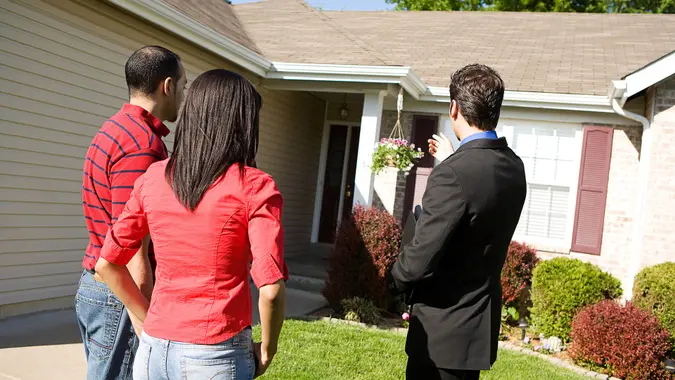The Average Homebuyer Age Is Now 56: What This Means for Millennials and Gen Z

Commitment to Our Readers
GOBankingRates' editorial team is committed to bringing you unbiased reviews and information. We use data-driven methodologies to evaluate financial products and services - our reviews and ratings are not influenced by advertisers. You can read more about our editorial guidelines and our products and services review methodology.

20 Years
Helping You Live Richer

Reviewed
by Experts

Trusted by
Millions of Readers
According to a report by the National Association of Realtors (NAR), the median age of homebuyers hit an all-time high of 56 this year, up from 49 in 2023 — and 31 in 1981.
Combined with the fact that the number of first-time buyers hit an all-time low, making up a mere 24% of the market, it’s no wonder many millennials and Gen Zers feel the American Dream of homeownership is now out of reach.
And with home prices up 39% since 2020 and mortgage rates following suit, many fear their American Dream insomnia might be permanent. But is that really the case?
How Did We Got Here?
Like many changes in the past few years, the coronavirus pandemic is partly to blame for the younger generations getting locked out when it comes to home ownership.
During and after the pandemic, the U.S. government bottomed out interest rates, leading to incredibly low mortgage rates, said Christy Bunce, president of New American Funding.
“Many existing homeowners who would have traded up into larger or nicer homes are locked into low mortgage rates. That means there are fewer starter homes available, driving up prices,” she said. “Additionally, investors and second homebuyers have entered the market, further driving up prices.”
And just to add insult to injury, homebuilders have been unable to keep up with new home demand thanks to increased material costs and labor shortages. That pushed prices even higher.
All this is coinciding with the Gen Z and Millennial generations coming into peak homebuying ages, their 20s to early 40s, said Bunce.
Will It Change?
Things that go up, come back down, right? Well, when it comes to housing, gravity doesn’t necessarily apply.
“The truth is, these high prices are here to stay, at least for now,” said Alexei Morgado, a Florida-based real estate agent and founder of real estate exam preparation firm Lexawise.
“There would have to be significant changes in inventories or measures of affordability before any kind of large price decline would be more likely to happen.”
He said that prices likely won’t drop dramatically until more homes are built or broader affordability programs are put in place.
There is hope, however.
“It’s possible that mortgage rates may come down a bit next year. That should improve affordability for buyers, provided home prices don’t shoot up as a result of the lower rates,” said Bunce.
“Lower rates should also entice more people to put their homes on the market, which should help alleviate the inventory concerns.”
What Can the Average Millennial or Gen Zer Do?
First, don’t give up hope. There are strategies that younger buyers are employing to buy their first homes.
Multigenerational or Multi-Family Homes
“One increasing tactic is buying multigenerational homes, where multiple family members share the space, and the cost. That’s already how 17% of buyers are trying to save on expenses,” said Morgado.
Another similar trend is friends buying homes together. He also advised flexibility.
“Consider trying less popular neighborhoods, homes that could use a little TLC, or maybe even options in financing,” he said.
First-Time Buyer Programs and Renovation Loans
Many young homebuyers are unaware of local, state and federal first-time homebuyer programs that they could leverage.
“There are first-time buyer programs that allow less down payment and more flexible terms,” said Phil Crescenzo Jr., vice president of the Southeast division of Nation One Mortgage Corporation.
In addition, he noted unique alternatives, such as renovation loans, which allow buyers to purchase homes that need major renovation. Instead of having to front the cost of renovation, buyers can borrow it to purchase a home under market value.
Smaller Homes, Bigger Savings
The fact is, younger buyers might have to compromise when it comes to the type of home they buy. Bunce suggested young buyers consider options such as condos or townhomes, which are typically less expensive than single-family homes.
That, combined with saving aggressively and other alternative tactics, could make the difference. A larger down payment can garner a better interest rate and possibly avoid the need for mortgage insurance, she said.
The Bottom Line
The fact is, a quick study of housing prices over the past 60 years shows that dips are rare and short-lived. Prices go up, and then up some more. And we are living in an era when prices went up dramatically.
For instance, in Q2 of 2022, the median sale price of a house in the U.S. was $317,100. Just two years later, in Q2 of 2024, it was $437,700. That’s our new reality.
So, the old rules of buying a first home might not work. The good news is, the new generation is known for breaking the rules.
 Written by
Written by  Edited by
Edited by 

























